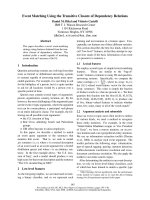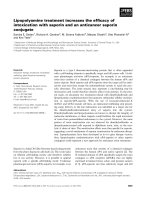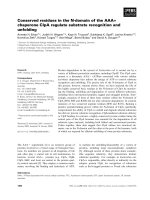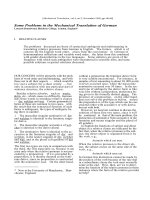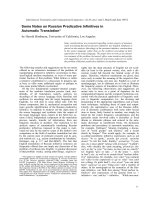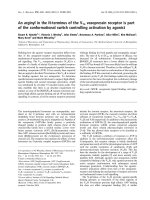Báo cáo khoa học: "Concluding thoughts on the new nature of disaster management" pptx
Bạn đang xem bản rút gọn của tài liệu. Xem và tải ngay bản đầy đủ của tài liệu tại đây (32.69 KB, 2 trang )
Page 1 of 2
(page number not for citation purposes)
Available online />Environmental cataclysms will be with mankind even after we
have learned to prevent man-made disasters. Prior to
Hurricane Katrina, disaster planning, preparedness, and
responses were mostly theoretical and based on our
preconceived notions of what a disaster should be [1] and
were mostly untested, except on relatively small scales.
Katrina has changed that in many ways. We knew Katrina
was coming, and we knew with uncanny precision how it
would affect us. We watched it approach, arrive, and depart.
We articulated what we should do and we found out vividly
what we couldn’t do despite our best intentions.
Virtually all our previous responses to environmental disaster
involved protecting citizens from adverse effects and then
resuscitating survivors after the fact [2]. Now, we have found
that most of that paradigm has been rendered moot and
radically new concepts have taken their place. As pointed out
by the authors of the reports presented here, virtually all of
our previous ‘disaster plans’ – including those in hospitals –
were woefully inadequate and failed miserably [3]. Unless we
learn the present and future logistical problems of
environmental disasters, we cannot effectively plan for them.
Part of that process is deciding whether we are more
interested in constructing or blaming. Americans are
notorious for blaming public officials for inadequacies, real or
imagined [4]. Public servants are a convenient target for
blame when things go wrong, but if there is any blame, it is
rarely unilateral. More to the point, assigning blame is by its
nature anticonstructive, and we need more construction – not
more blame. Accordingly, Americans speculated on blame,
fueled by the same media process that spawned tabloid
news, but on a separate level we maintained construction.
We all pitched in and tried to make it better as well as we
could, including money and time donated through multiple ad
hoc relief agencies [5]. And we learned.
Health care providers, rendered powerless by lack of
facilitative technology and hardware, opened their
imaginations and thought ‘outside the box’ to make things
work. If sick patients could not be extricated in traditional
ways, then more nontraditional routes mobilized them. Field
expediency moved mountains previously thought immobile.
Concepts that did not work were quickly abandoned and
other more effective modes were identified by rapid trial and
error. When public officials failed, private citizens rallied [6].
We learned that trauma is not the major issue after the event.
Thus, the traditional horde of do-gooders flooding into the area
to help actually hindered, as it did after the 9/11 disaster in
New York City [7]. It was not previously clear that there is no
practical way to evacuate a major city, and any attempt to do so
also limits mobility within the disaster area [8]. All roads and
airports are jammed. There is no way to get anywhere after any
government air transport is facilitated. Ultimately, escaping
citizens were told they might be safer staying in their homes
than trying to flee [9]. Others refused to leave the perceived
safety of tried and true, placing themselves and rescuers in
jeopardy. Accordingly, a major problem will be dealing with
transportation of and living arrangements for thousands of
victims, not treating their illnesses. Additionally, the issue of
integrating thousands and potentially millions of people into
new social and physical environments must be dealt with.
We are learning about the nature of ‘martial law’, rarely used
in the past, and how it applies to the future. Use of federal
troops for domestic support is problematic because of its
potential abuse of civil liberties and its legality problems. If
anything, however, the Katrina disaster has shown that it will
be necessary for some centralized authority to take control of
disaster management much earlier than we previously
thought. Society must give up some of its individual liberties
to promote order and avoid anarchy during national
emergencies. The military has the organizational ability to do
many things that civilians cannot, no matter how well
intentioned they may be. It must be remembered, however,
that military stabilization is a very cold, dispassionate
business, performed by humorless, authoritative proponents
carrying weapons [10]. Are we willing to pay that price for
order [11]?
Editorial
Concluding thoughts on the new nature of disaster management
David Crippen
Associate Professor, Director, Neurovascular ICU, Department of Critical Care Medicine, University of Pittsburgh Medical Center, Pittsburgh,
Pennsylvania, USA
Corresponding author: David Crippen,
Published: 14 December 2005 Critical Care 2006, 10:111 (doi:10.1186/cc3946)
This article is online at />© 2005 BioMed Central Ltd
Page 2 of 2
(page number not for citation purposes)
Critical Care Vol 10 No 1 Crippen
We are learning that communications ability must be a reality
long before any disaster occurs, and that we must not try to
figure it out after the event. It seems clear that the event
caused major network outages, which could have been
prevented with more planning [12]. Satellite backbones do
not yet have the carrying capacity to provide core
infrastructure, but this will come in time. Also, wireless LAN
(local area network) and WAN (wide area network) will
become important for local communication. Relatively
antiquated communication modes such as amateur radio
have enjoyed resurgence, and coupled with satellite Internet
capability they may well revolutionize our effective response
to disaster care [13].
Perhaps most of all, we are slowly learning that entitled
individuals living in very comfortable circumstances may very
well find themselves in dire straits even if they see disaster
coming and have time to plan. Power can go out for huge
areas for days or weeks. Potable water flow can cease.
Damage can be done from almost any front. It is now clear
that private citizens must move to establish a drill to protect
themselves and their families now [14]. At the very least, a
supply of drinking water must be secured, as must a small
power generator to provide electricity for essentials and a
supply of stabilized gasoline (lasts for years) to run the
generator and power automobiles for essential and
emergency travel.
This is the future of disaster management.
Competing interests
The author(s) declare that they have no competing interests.
References
1. Angus DC, Pretto EA, Abrams JI, Safar P: Recommendations for
Life-Supporting First-Aid training of the lay public for disaster
preparedness. Prehospital Disaster Med 1993, 8:157-160.
2. Crippen D: The World Trade Center attack. Similarities to the
1988 earthquake in Armenia: time to teach the public life-sup-
porting first aid? Crit Care 2001, 5:312-314.
3. The Kimery report: Katrina exposes post-9/11 disaster unpre-
paredness. [ />Katrina_Lays_Bare_Post_911_Catastrophe_Unpreparedness.cfm]
4. Gresham R: Going … going … gone? Federal Emergency
Management Agency. Emerg Med Serv 1994, 23:42-52.
5. The Salvation Army international home page [-
vationarmy.org/]
6. Kennedy MS, Jacobson J: The Gulf coast’s devastation: nurses
respond to Hurricane Katrina. Am J Nurs 2005, 105:19.
7. Martinez C, Gonzalez D: The World Trade Center attack. Doctors
in the fire and police services. Crit Care 2001, 5:304-306.
8. Harden B, Moren S: Thousands fleeing Rita jam roads from
coast. Washington Post 2005, September 23:A01.
9. Joyner JR: Running out of gas in evacuation traffic jams.
[ />10. Villa J: Rescuers to stay armed. The Arizona Republic Oct. 7,
2005 12:00 AM [ />11. Van Auken B: New Orleans becomes a war zone. A dress
rehearsal for martial law? [ />sep2005/nola-s08.shtml]
12. Centers for Disease Control and Prevention: Hurricane Katrina
response and guidance for health-care providers, relief
workers, and shelter operators. MMWR Morb Mortal Wkly Rep
2005, 54:877.
13. Niemtzow RC, Yarbrough G, Harwood KL, Jacobs JL, Burkett S,
Greaves WW, Reutershan TP, Rebuck HI, Posner S, Clark W, et
al.: The amateur Radio Emergency Service (ARES) and the
National Disaster Medical System (NDMS). Mil Med 1993,
158:259-263.
14. Federal Emergency Management Agency [http://www.
fema.gov/]



